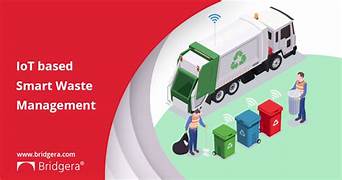Smart Waste Management Systems Using AI: A Revolution in Sustainability
As urbanization continues to grow, waste management has become a critical challenge for cities worldwide. Traditional methods of waste collection and disposal often lead to inefficiencies, increased costs, and environmental hazards. In response to these challenges, artificial intelligence (AI) is emerging as a transformative force, introducing innovative solutions to make waste management smarter, more efficient, and environmentally sustainable.
This article explores the role of AI in revolutionizing waste management systems, the technologies involved, their benefits, real-world applications, and the challenges that come with implementation.
The Need for Smart Waste Management Systems
The global waste problem is staggering. According to the World Bank, the world generates over 2 billion tons of municipal solid waste (MSW) annually, with at least 33% of it not being managed in an environmentally safe manner. The impacts of poor waste management are profound:
- Environmental Pollution: Improper disposal leads to air, soil, and water pollution.
- Resource Depletion: Many recyclable materials end up in landfills, wasting valuable resources.
- Health Hazards: Unmanaged waste attracts pests and emits harmful gases, posing health risks.
- Economic Losses: Inefficient systems result in higher operational costs and lost opportunities for recycling.
Smart waste management systems powered by AI offer a solution to these challenges by leveraging data-driven insights and automation.
How AI Works in Waste Management
AI integrates machine learning, computer vision, IoT (Internet of Things), and data analytics to optimize the various stages of waste management, including collection, sorting, recycling, and disposal.
1. Data Collection and Monitoring
AI systems use IoT-enabled sensors to monitor waste bins and collection points in real time. These sensors detect:
- The level of waste in bins.
- Types of waste (e.g., recyclable, organic, hazardous).
- Environmental factors like temperature or odor, indicating hazardous conditions.
2. Predictive Analytics
Machine learning algorithms analyze historical and real-time data to predict:
- Waste generation patterns in specific areas.
- Optimal collection schedules to prevent overflow.
- Future waste management needs based on population and consumption trends.
3. Smart Routing for Collection Vehicles
AI-powered route optimization ensures that garbage trucks take the most efficient paths, reducing fuel consumption and operational costs. The system dynamically adjusts routes based on real-time data, such as traffic conditions and bin status.
4. Automated Waste Sorting
AI systems equipped with computer vision and robotic arms can identify and sort waste materials on recycling conveyor belts. Advanced image recognition algorithms classify waste into categories like paper, plastics, glass, and metals with high accuracy.
5. Recycling and Resource Recovery
AI enhances the efficiency of recycling facilities by identifying materials that can be reused or repurposed. For instance, it can detect contaminants in recyclable streams, ensuring higher purity in processed materials.
6. Public Awareness and Behavior Change
AI-driven mobile apps and platforms educate the public on waste segregation and recycling. Personalized insights and gamification encourage sustainable practices among individuals and businesses.
Applications of AI in Smart Waste Management
1. Optimized Waste Collection
Smart bins equipped with AI sensors notify waste management authorities when they are full. This eliminates unnecessary trips to empty bins that are not full and ensures prompt collection where needed.
2. Waste-to-Energy Conversion
AI helps optimize waste-to-energy plants by analyzing the calorific value of waste and determining the most efficient methods for energy recovery.
3. E-Waste Management
Electronic waste (e-waste) is one of the fastest-growing waste streams globally. AI systems can identify and sort e-waste components, such as batteries and circuit boards, facilitating safe disposal and material recovery.
4. Industrial Waste Monitoring
AI monitors industrial waste to ensure compliance with environmental regulations. Predictive analytics help industries minimize waste generation and optimize recycling processes.
5. Smart Composting
For organic waste, AI-powered composting systems monitor decomposition conditions, such as temperature and moisture, to ensure efficient compost production.
6. Circular Economy Integration
AI facilitates the transition to a circular economy by identifying opportunities for reusing and repurposing waste materials. This reduces dependency on raw materials and promotes sustainability.
Benefits of AI-Powered Waste Management Systems
1. Cost Efficiency
Optimized collection routes and schedules reduce operational costs, including fuel and labor expenses. Automated sorting minimizes the need for manual labor in recycling facilities.
2. Environmental Sustainability
Efficient waste sorting and recycling reduce the amount of waste sent to landfills, conserving resources and minimizing pollution. AI also supports initiatives like waste-to-energy conversion, promoting cleaner energy solutions.
3. Improved Public Health
AI systems ensure timely waste collection and disposal, reducing exposure to harmful waste and preventing the spread of diseases.
4. Real-Time Decision Making
AI provides actionable insights through real-time data analysis, enabling authorities to respond promptly to waste-related challenges.
5. Enhanced Recycling Efficiency
AI-powered sorting systems achieve higher accuracy and speed, increasing the recovery rate of recyclable materials and reducing contamination.
6. Better Resource Utilization
By predicting waste generation patterns, AI helps in allocating resources more effectively, ensuring that waste management systems operate at optimal capacity.
Real-World Examples
1. Amsterdam, Netherlands
Amsterdam uses AI to optimize its waste collection process. Sensors in public bins provide real-time data on fill levels, allowing for efficient collection schedules and reducing the number of trips made by garbage trucks.
2. Pune, India
The city of Pune implemented an AI-powered waste sorting system to manage its growing municipal waste. The system uses computer vision to identify and sort recyclable materials, significantly increasing recycling rates.
3. Helsinki, Finland
Helsinki employs AI-driven waste-to-energy systems to convert organic and non-recyclable waste into electricity and heat, reducing its reliance on fossil fuels.
4. Rubicon Global (USA)
Rubicon Global uses AI to provide waste management solutions for businesses. Its platform analyzes waste data to suggest strategies for waste reduction and recycling, helping companies meet sustainability goals.
Challenges in Implementing AI in Waste Management
1. High Initial Costs
The deployment of AI systems, including sensors, hardware, and software, requires significant investment. This can be a barrier, especially for developing countries.
2. Data Privacy Concerns
The use of IoT devices and real-time data collection raises concerns about the privacy and security of data.
3. Integration with Legacy Systems
Many cities and waste management companies still rely on outdated systems, making integration with AI technologies challenging.
4. Public Awareness and Participation
AI systems are only as effective as the participation they receive from the public. Ensuring proper waste segregation and disposal practices remains a challenge.
5. Technological Limitations
While AI systems are highly efficient, they may struggle with non-standard waste items or heavily contaminated materials, affecting sorting accuracy.
Future of AI in Waste Management
The potential of AI in waste management is vast, and advancements in technology will continue to enhance its capabilities:
1. Integration with Smart Cities
As cities become smarter, AI-driven waste management systems will seamlessly integrate with other urban infrastructure, such as energy grids and transportation systems.
2. Autonomous Waste Collection
Robotic garbage trucks and drones equipped with AI could automate waste collection in hard-to-reach areas or during emergencies.
3. Advanced Recycling Techniques
AI will play a crucial role in developing next-generation recycling technologies, such as chemical recycling for plastics, to achieve near-zero waste goals.
4. Circular Economy Expansion
AI will enable more efficient resource recovery, accelerating the transition to a circular economy where waste is minimized, and materials are reused.
Conclusion
AI-powered smart waste management systems are a game-changer in addressing the global waste crisis. By leveraging advanced technologies, these systems enhance efficiency, promote sustainability, and improve public health. While challenges remain, the potential benefits far outweigh the drawbacks, making AI an essential tool for cities aiming to build a cleaner and greener future.
As we move forward, investments in AI and public awareness campaigns will be crucial to unlocking the full potential of smart waste management systems. Together, technology and human effort can pave the way for a world where waste is no longer a problem but a valuable resource.


